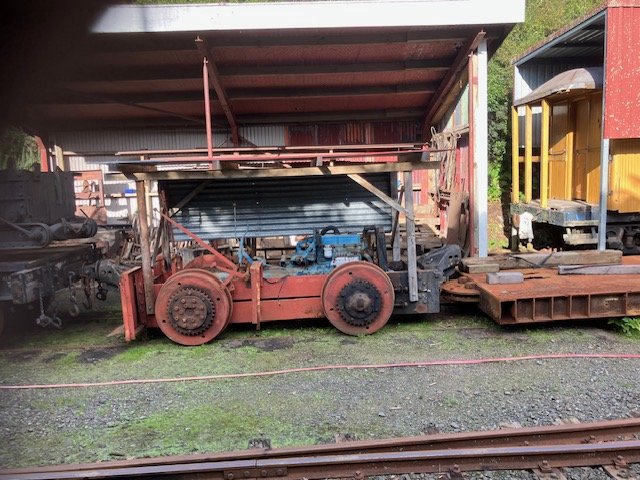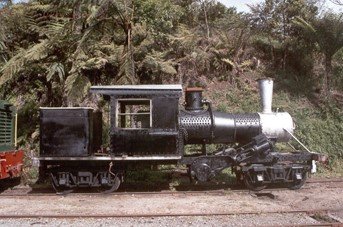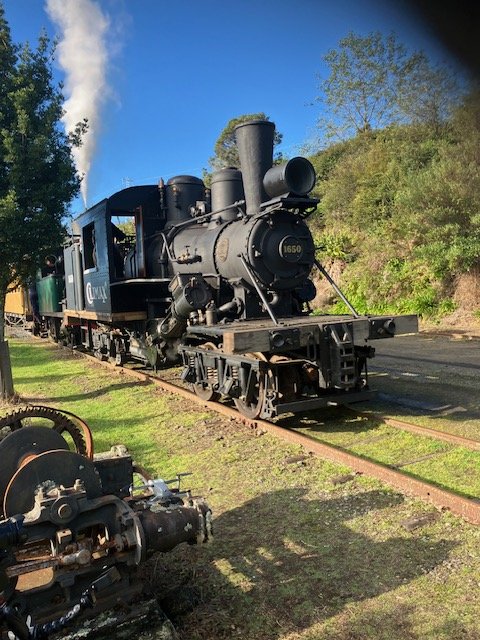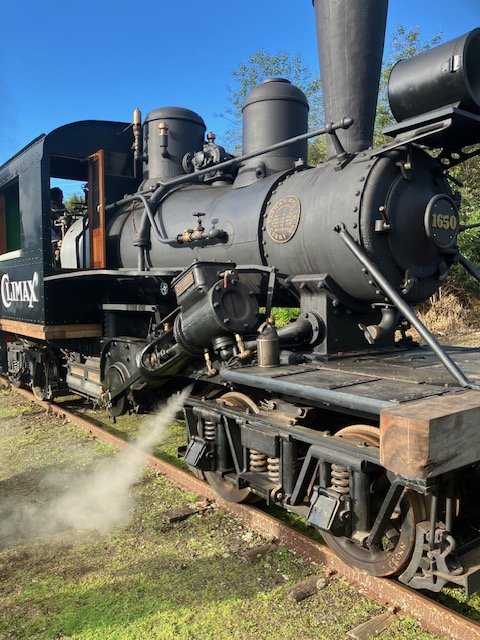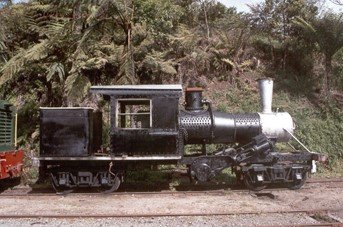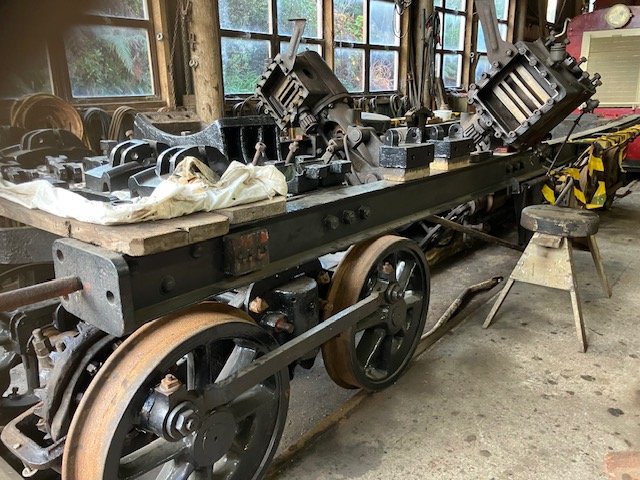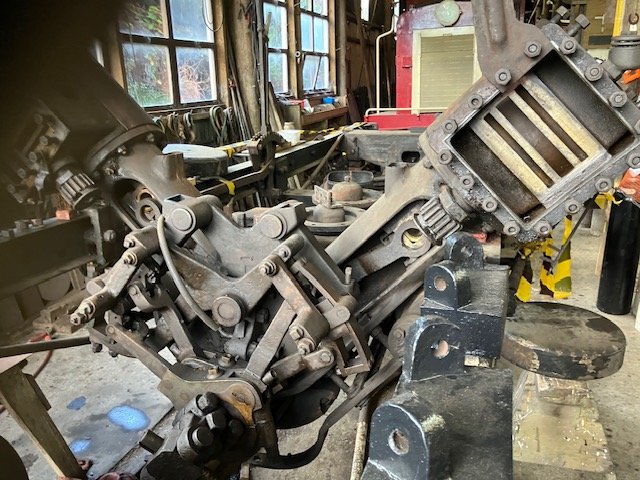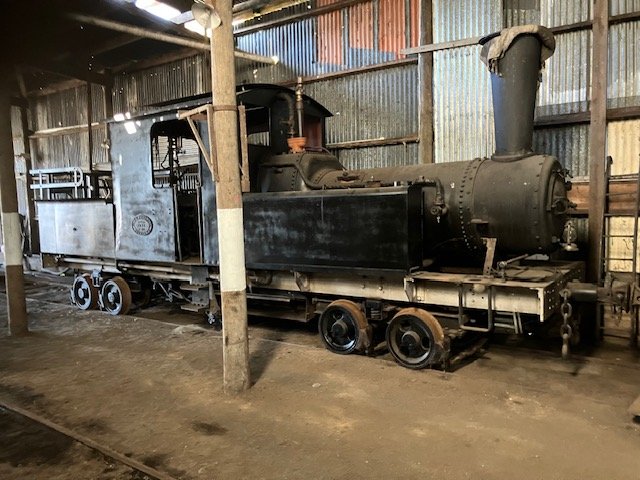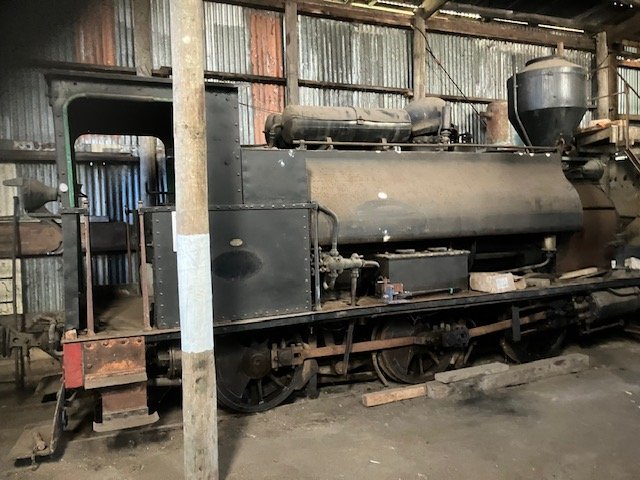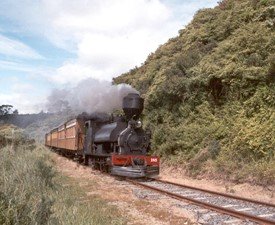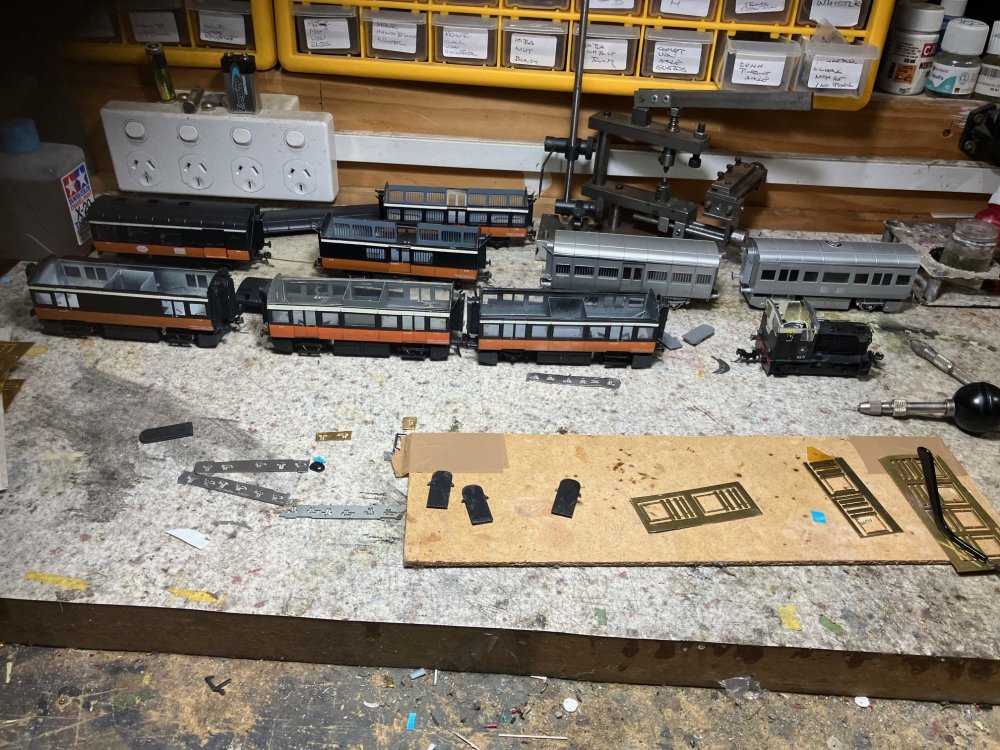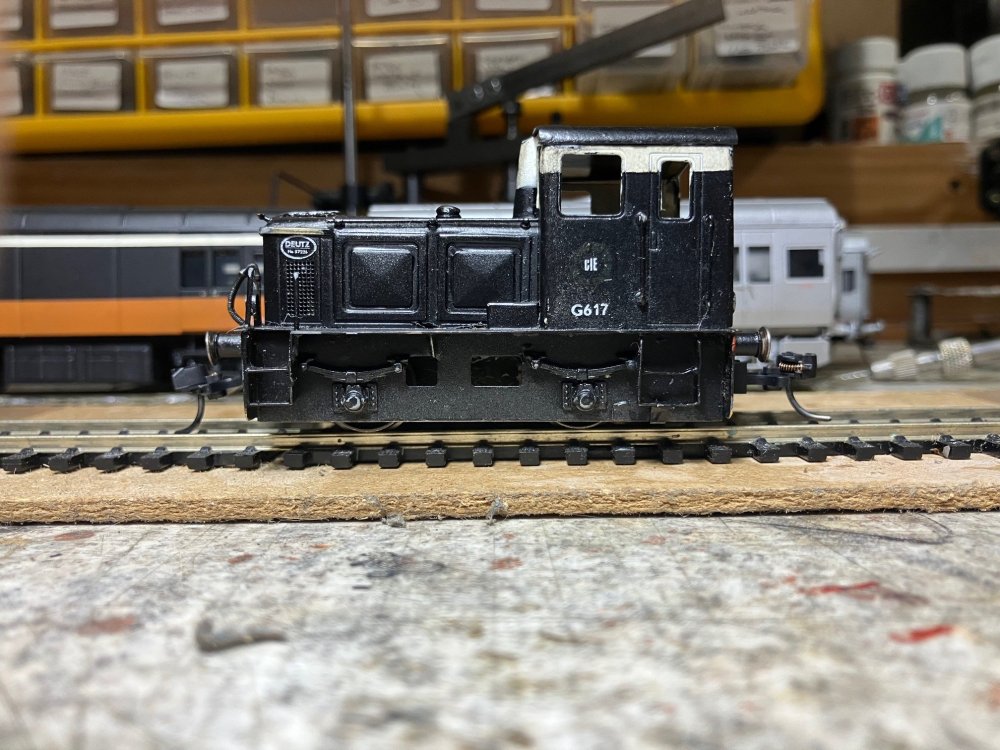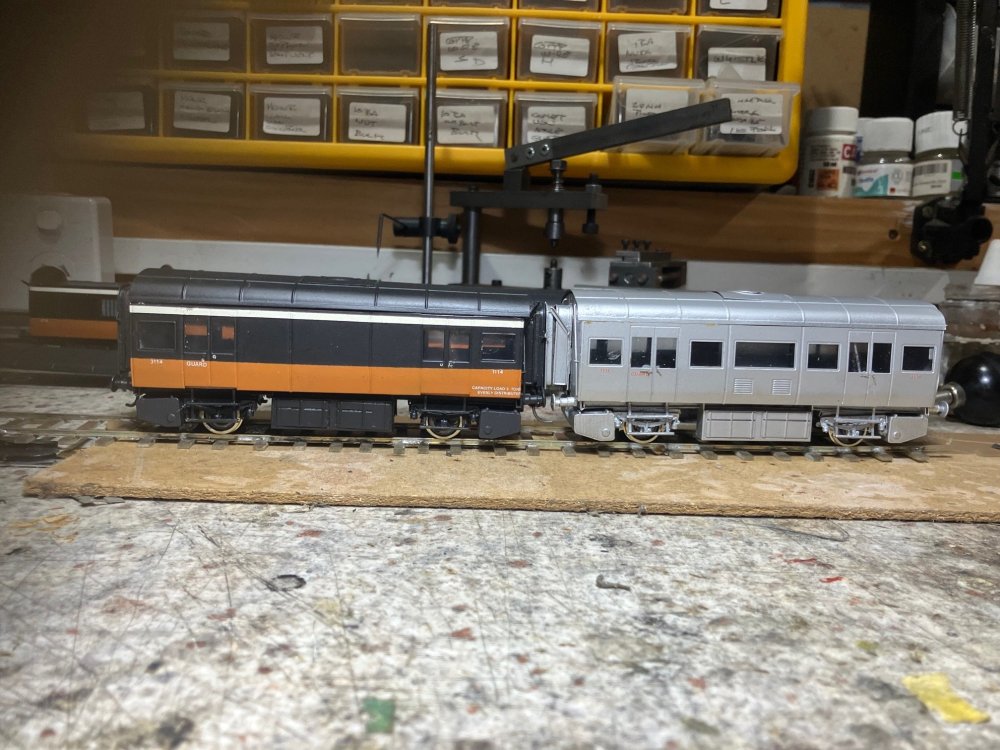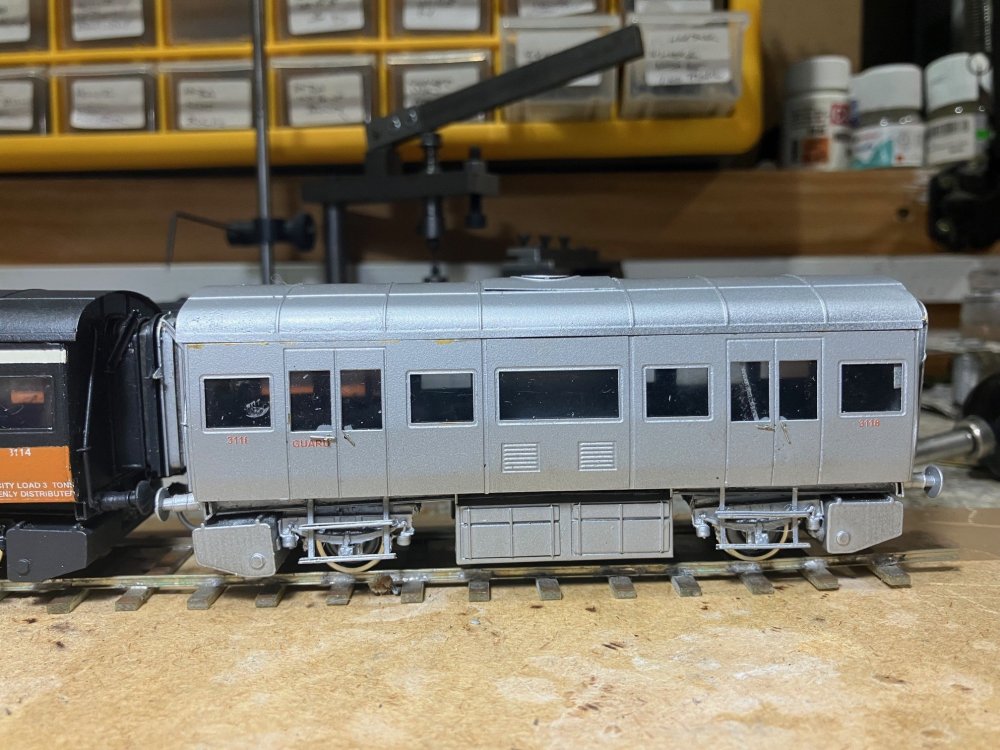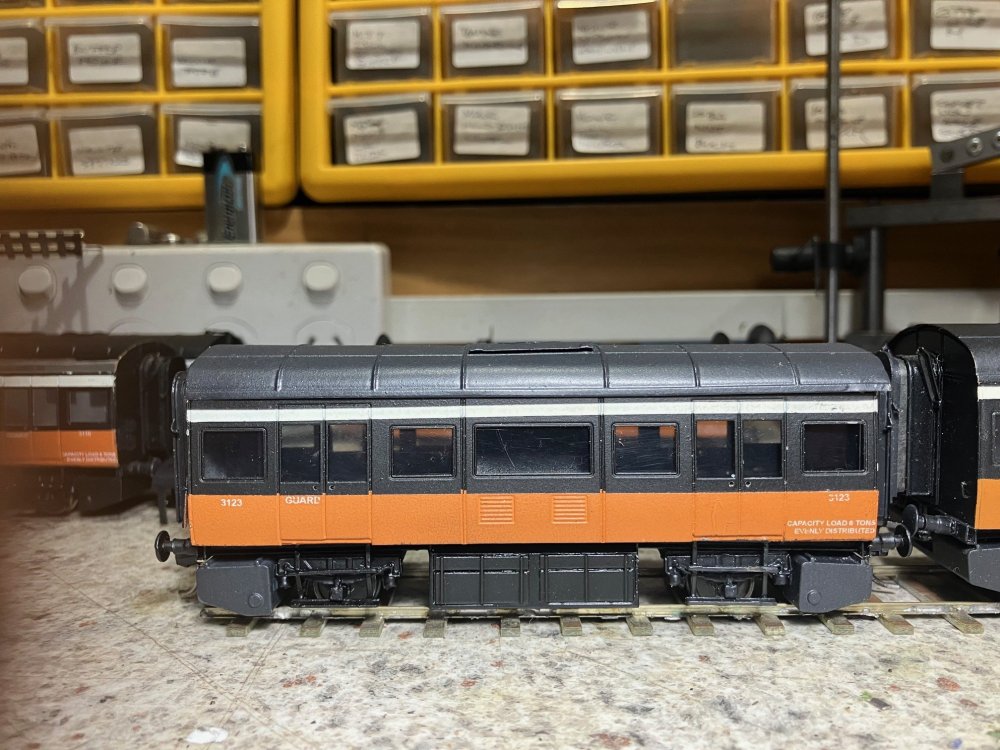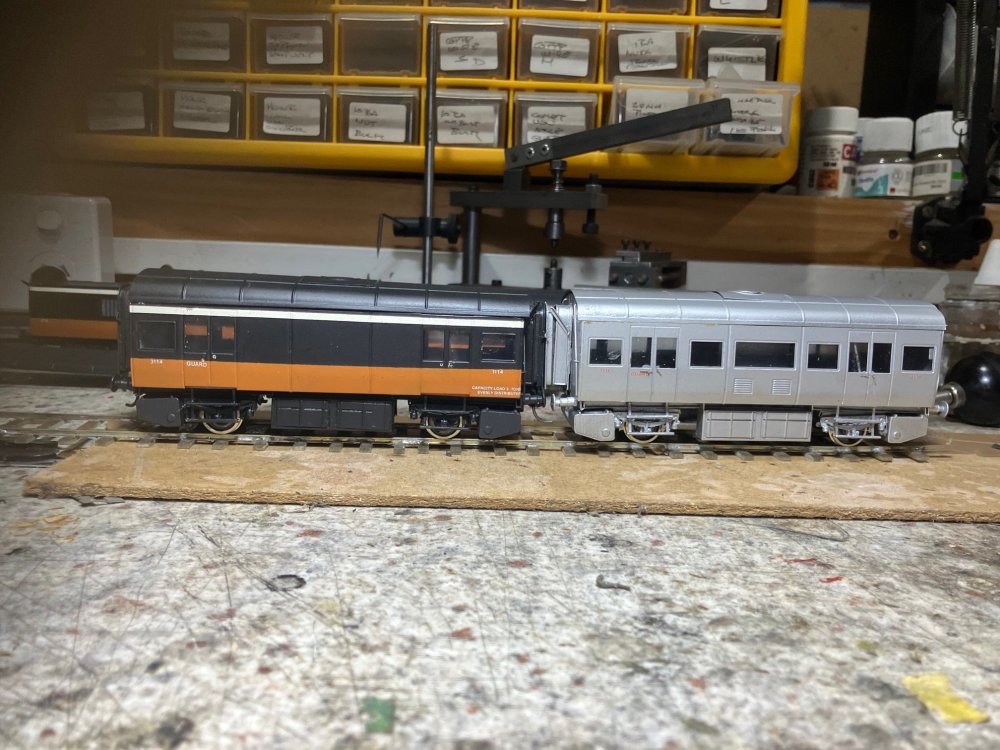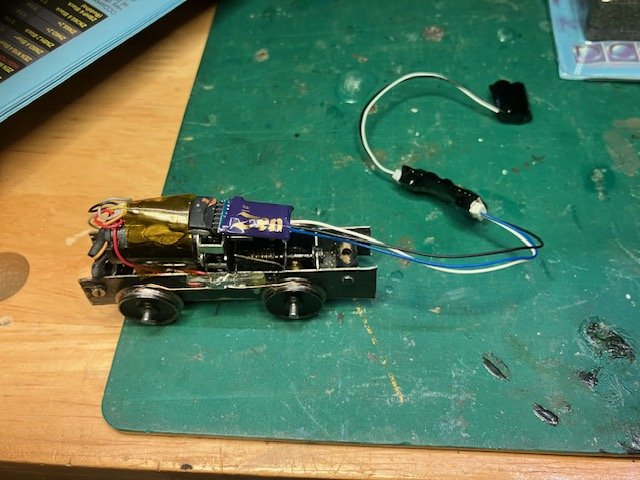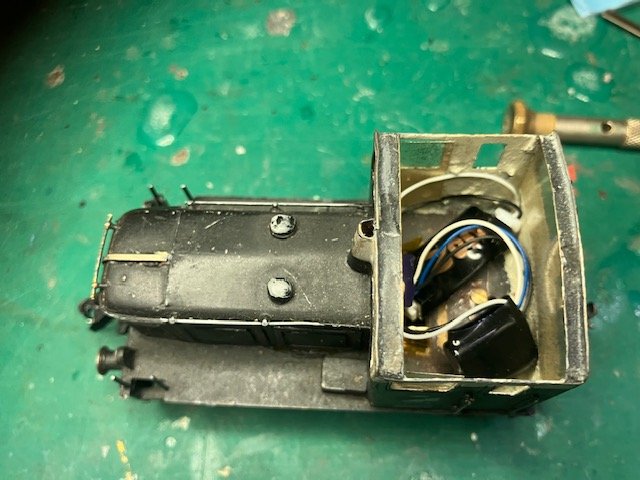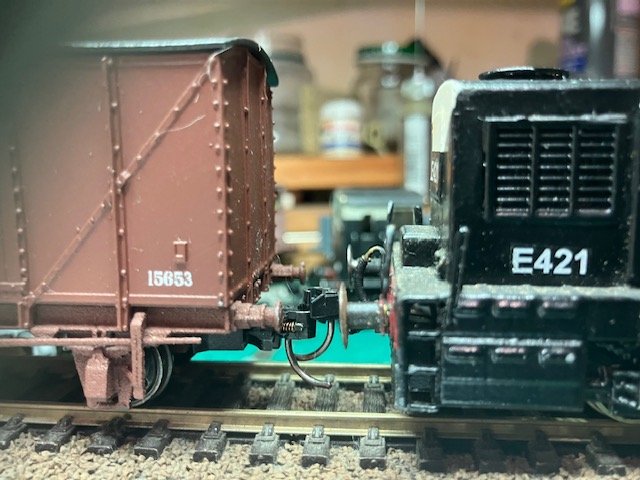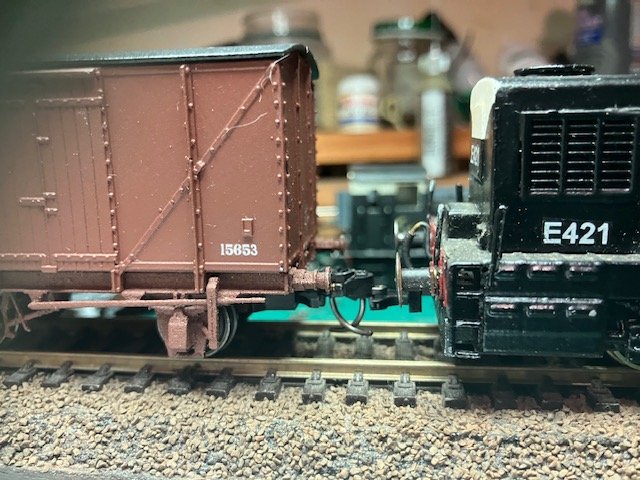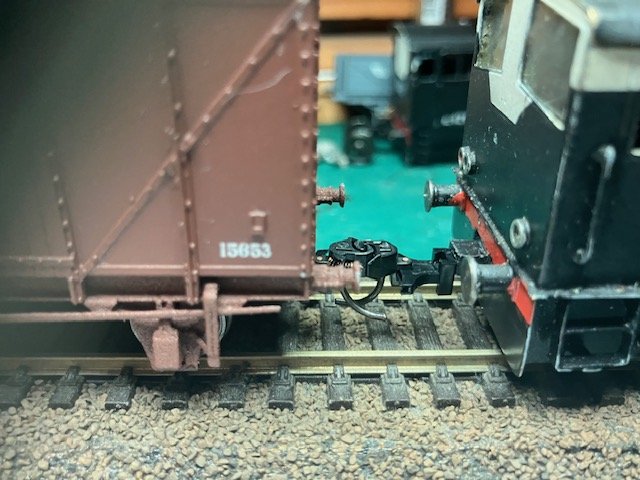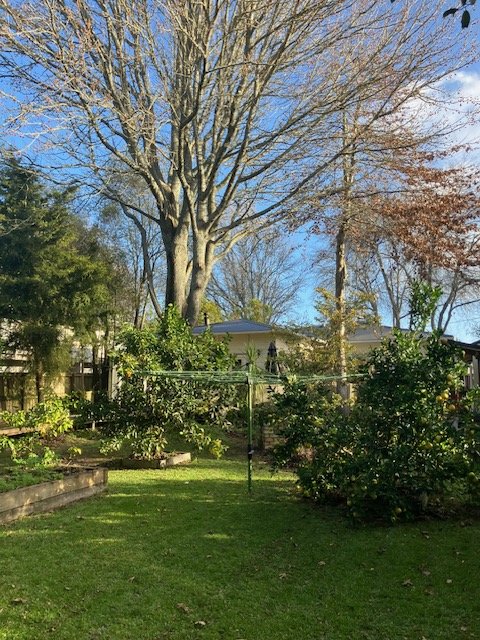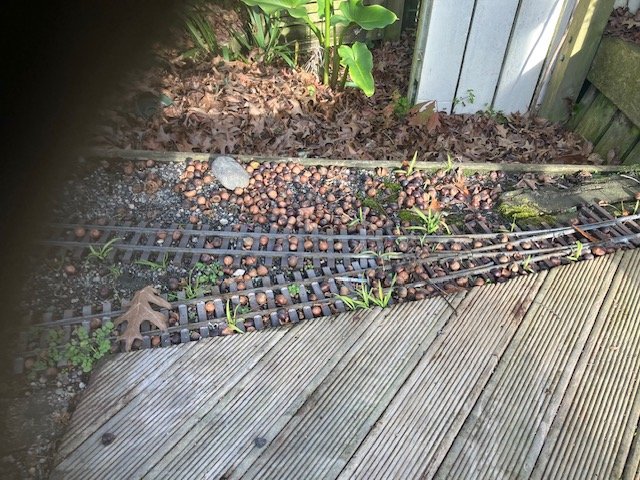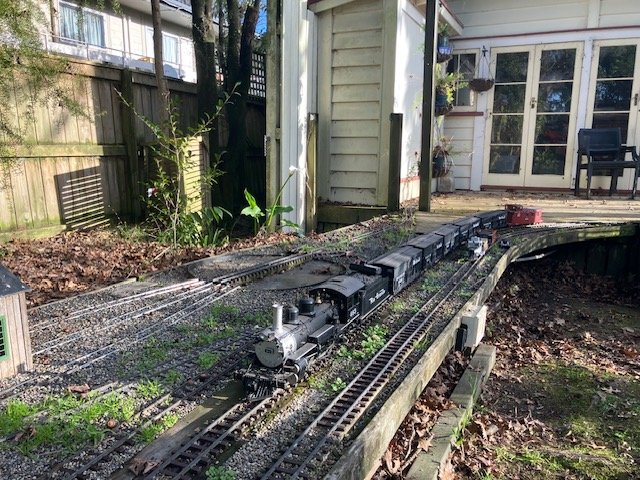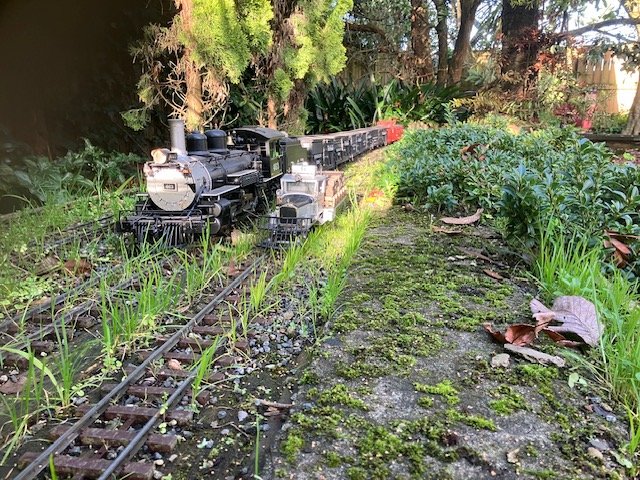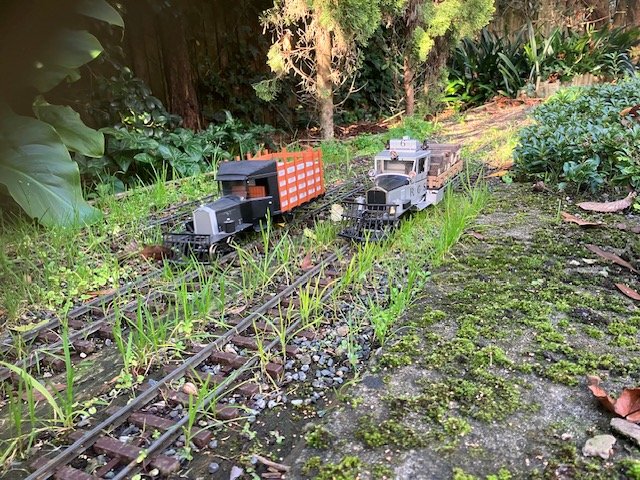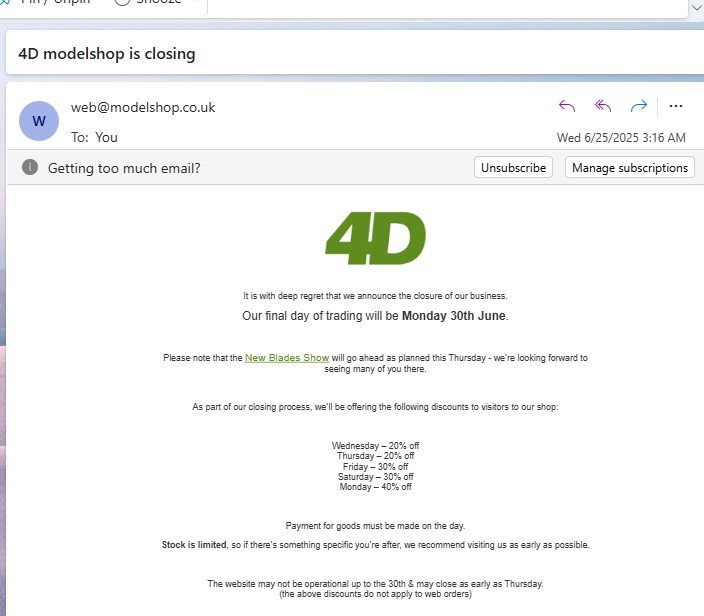-
Posts
4,737 -
Joined
-
Last visited
-
Days Won
119
Content Type
Profiles
Forums
Resource Library
Events
Gallery
Blogs
Store
Community Map
Everything posted by Mayner
-

Climax Locomotive 1650 restored to steam after 68 years
Mayner replied to Mayner's topic in Photos & Videos of the Prototype
Some odd IC stuff too Steam often replaced by "Tractors" manufactured by foundries in remote area's that once produced steam powered machinery for the mining and logging industries, this leading axle on this tractor would have been powered by a chain drive from the rear axle. Possibly from the Dispatch Foundry on the West Coast of the South Island and important mining area. "White Jigger" or railtruck converted from a White Truck (US manufacturer) once used to transport workers on a bush tramway in the Central North Island, an extensive restoration was carried out by the owner in his own workshop. Truck is used to give passenger rides on operating days won a Weta Workshops award for Creativity in Restoration. A second more ornate Chevvie truck required a more extensive restoration https://www.bushtramwayclub.com/locoimages/indexbushjiggers.html- 1 reply
-
- 4
-

-
Visited the Bushtramway Club on their monthly operating day yesterday my first afternoon off in two years, the big surprise was to see Climax 1650 in steam operation double heading a passenger train. The loco owned by a Trust was last steamed 65 years ago and recently won this years Federation of Railway Organisations of New Zealand restoration award. Yeah the Climax was in steam, being a geared loco moving very slowly not showing smoke and steam as I toook the photo. I had last seen the loco un-restored about 12 years ago The Climax locomotives were American manufactured geared locomotives capable of running on steeply graded, sharply curved, often temporary track once common on Logging Railroads or Bush Tramways (NZ) and once were a popular type on Bush Tramways. 1650 which was used on one of the last remaining Central North Island bush tramway operations was rescued by a group of enthusiasts during the 1960s and restored to working order off site in a Central North Island general engineering workshop in the region where the loco formerly operated. Ironically I noticed a steam loco cab outside the workshop while working in the area but never drew the connection with the Climax or called in to have a look. The Bush Tramway has a collection of ex-mail line and industrial locos (drawn from logging, dairy and meat processing industries) with a high proportion of the restoration work carried out in the railways own workshop. Along with the Climax the Bushtramway Club has a collection of geared locos including a Heisler (American manufacture) and a couple of NZ built A G Price locos The Heisler currently under overhaul is similar in general principal to a Climax but with the engine arranged in a V powering a driveshaft which transmits power to the bogies by sets of bevel gears at the outer end of the trucks (bogies) with coupling rods transmitting power to the wheels. The Heisler boiler is currenty offsite for major repairs. A "Price B" the local equivalent of a "Climax A" powered by a vertical steam engine in the cab, boilers often un-lagged on NZ "Bush Lokies" This loco regularly ran up & down the Pukemiro station yard on operating days. More conventional the NZR F Class 0-6-0ST the standard main line loco of the early years of the New Zealand railway system until replaced by increasingly larger locos as the system expanded and loads increased. This loco 185 was sold into industrial service with one of the local coal mines and and the regular 'main line' loco on the Bushtramway during the 2000s but requires major boiler/firebox work.
- 1 reply
-
- 6
-

-
Ironically Brian Fennel a MRSI member used rubber band drive (similar to Athearn Hi-Fi system) to power several scratchbuilt CIE 001 Class diesels during the early 70s. Like the Athearn models Brian's diesels featured a central flywheel motor with drive (by rubber band) to all axles on both bogies (possibly Athearn parts). The 001s (plasticard body, all metal chassis) were used to haul a CIE Supertrain formed from Triang-Hornby MK2 coaches, as far as I recall the locos were fast/smooth riding and reliable).
-
Seems to be a classic with its simple track layout and positioning of the buildings, I seem to have stumbled on the same formula in two of my layouts built 30 years apart, possibly inspired by John Harrison's Torpoint rather than Courtmacsharry! I was tempted to build a 7mm T&C layout in the garage about 10 years ago though focused on Timoleague, the Alphagraphix loco and stock kits would have been a good start but already (over) committed to 4mm and Large Scale. The T&C although including a roadside tramway seemed to be more in the Colonel Stephens/Tanat Valley rather than Irish style of Light Railway with Industrial style locos and very simple iron buildings, Timoleague with its simple 'works" almost an Iain Rice project, though I don't know how I would fit in the Abbey.
-
I guess the big question is whether demand for Commuter and Intercity passenger services will continue to increase in this era of instability and technological change. In Wellington and to a lesser degree Auckland rail passenger numbers dropped significantly in recent years despite significant rolling stock and infrastructure investment https://www.thepost.co.nz/nz-news/360717804/frustrations-all-round-train-patronage-plummets#:~:text=Train trips taken on the,during the past financial year. While the article writes about road improvements (Transmission Gully), reliability issues and more working from home, fewer people are now commuting to work in Wellington as a result of public and private sector cuts/redundencies--estimated 5000 Public Sector redundencies in the City since 2023. When I worked for a Irish Government agency over 20 years ago, the policy was to "de-centralise" Departments and Agencies from Dublin to the Provinces until someone realised the potential economic shock of transferring several thousand public servants and their families from Dublin to the Provinces. Ironically although based in Head Office in the days before high speed internet, I teleworked successfully from home for several years using a dial-up free phone number only visiting the office when absolutely necessary. One of the main issues with remote working is the impact of empty office blocks on the Financial Sector (Pension Funds, Insurance Companies) and city centre cafe's and other retailers. Back in the 90s when I worked in the UK construction sector my next project was to be the re-development of the Bullring (Birmingham) following the successful completion of the Watford Harlequin Centre, unfortunately our client a major UK Insurer made a £100m underwriting loss the previous year as a result of the "Great Storm of 1987" and I was out of work and the project indifinitely postponed. I returned to Ireland several years later during which I stuck mainly to industrial and warehousing projects, with one 'final" Dublin office block several years before the Irish Commercial Property bubble burst in 2009. Having weathered two property recessions the Irish Public Sector appeared more stable! Interestingly following the debacle with the "Mini-CTC project of the Mid 90s--IE designed and managed the majority of its infrastructure projects in-house using specialist contractors where necessary, PW & SE (Signalling and Electrical) in house. Interestingly a Drogheda track gang carried out the Heuston track layout re-modelling having successfully completed the Northern Line upgrade, though like the MK3 Carriage builders of the 1980s, I guess many of the people the managed and carried out the infrastructure improvements of the late 90s-20s have retired. One of the more interesting aspects of returning from the UK in the 90s was the capability of Irish design and engineering firms and civil engineering contractors to undertake large and complex projects as a result of a combination of work undertaken with both Irish and Overseas clients, there is not a lot of difference from a civil engineering/construction project between building a road and a railway. Roadbridge an Irish firm successfully carried out civil works on the UKs HS2
-
Production Line Big break through this week cleared tools and accumulated junk from the workbench to complete a flotilla of Tin Vans I started between 5-years ago. The Vans were substantially complete, mainly door handles, gangway ends to add, replace some damaged/missing steps and complete paint touch ups to G617. Two steps forward and one back, completed paint touch ups to areas where black had worn off (handrails, edge of running board, shunters and cabs steps & blended and sealed with a semi-gloss clear, then replacement set of G Class decals arrived from Des this morning. I need to check the new CIE roundels for comparision! 3111 Tin Van 1955 as introduced condition, unmodified doors. Although I fitted door handles on previous builds, I found it challenging this time around over 10 years after I initially produced the kit. I need to adjust the axleguard assembly on the righthand side! 3123 with modified doors an early modification to these vans. 3114 a van with the majority of windows replaced with plain panels & 3111 a van in original as introduced condition. 3114 is based on a late 60s David Malone photo of the van at Sligo.
-
I managed to dig-up some more info. on the "self-heating coaches" 5 ex-GSWR Composite coaches 2089.2094,2096,2097 & 2098 were fitted with "Victor" diesel generators and initially considered 'moderately reliable", but generators removed by Jan 1960. Two were in use on the Clonakilty & Skibereen/Baltimore Branches. Its possible the other "self-heating coaches" may have been used on the Birr and Ballina branches with a C pottering around with a single passenger coach, Valencia passenger appears to have loaded up to 4 coaches behind a C, Galway-Tuam & Cork-Youghal appear to have been heavier A Class workings https://irishrailwaymodeller.com/topic/5693-characteristics-of-cie-metrovick-c-class-locomotives/ While I referred to Jan 56 and Jan 60 Irish Railfans News in the original post, the info on the "self-heating coaches" is likely to have appeared in the Jan 28 IRN or possibly later! While I haven't been able to track down 2089 the remaining "self-heating coaches" /fitted for electric train heating were all withdrawn by 1964. 2094 introduced as a 57' 1st/2nd/3rd in 1915 was withdrawn in 1964, 2096-8 were introduced as 57' 1st/2nd with GSWR later more spartan style of panneling between 1920-21 were withdrawn between 1962-3. There are diagrams of these coaches in the TRA reprint of the GSWR diagram book, but the diagrams are of limited use for modelling purposes as they show only one side of coaches which had different window and panneling arangements on the corridor and compartment sides.
-
Info originally appeared in "Irish Railfans News" during the 50s, IRN Archive posted on the RPSI website about 12 years ago, but no longer accessible! As far as I recall the 'self heating' carriages were fitted with an underfloor proprietary petrol-electric genset, apparently the gensets were unreliable in service and a number of C Class fitted with jumper sockets fir electric train heating. There is a 1968 picture in "Irish Metrovick Diesels: of a recently outshopped C203 in Black with yellow warning panel & buffer, with a silver power socket mounted vertically on the buffer beam. Ironic CIEs 1st exprements with electric train heating was with 30 year old coaches hauled by C Class diesels on West Cork branches. IRN article included coach numbers and info on gen-set I downloaded the articles at the time, possibly on some back up drive/archive the computer I used in 2013 gave up the ghost several years ago.
-
No heating on this particular train the brand new Tin Van is actually a Luggage Van no boiler for steam heating and notoriously rough riding that guard would seldom ride in if anything else was available. CIE converted a number of 20s era GSR Comp coaches into "Self Heating Coaches" (electric heating powered by an underfloor generator) for C Class haulage on Clonakilty & Skibereen/Baltimore branches.
-
Due to the level of interest I am considering supplying the Bullied Vans from New Zealand as complete kits with pre-formed brass roofs. I have most of the whitemetal detail castings and decals in stock, parts that are low/currently out of stock will be produced by 3D printing. I need to check the availability of parts for the MGW Horse Box and Meat Van I hope to finalise prices and lead time to delivery during the next couple of weeks.
-
Managed to find the remains of the decal set I used when I originally "completed" G617 (goodknows when) complete with replacements for the obliterated/damaged numbers and CIE, I also found a 'stash' of 6pin 1-2amp decoders I bought from the States several years ago but never used, when I had a problem with 0.7 amp decoders blowing on kit built locos. I am using "Gun Blue" as a blackening agent in areas where paint damaged/chipped exposing brass before touching up paintwork So at this stage a case of paint touch-ups and clear varnish to seal the decals and protect the paintwork. Another un-finished job from several years ago was to fit the fuel tanks and gangway covers to a Tin Van I assembled about 5 years ago Tanks (3D Printed) are both fixed to the floor of the van using 10BA bolts, originally intending to use a Kadee #36 couper, I have not fitted couplers at this stage (no Kadee #36 in stock and looking possibly at using smaller/more discrete B&B couplings (I have a fret of B&Bs somewhere) While I used to represent the flexible part of the gangway in the traditional manner using (soft) foam rubber wrapped in crept paper, I mounted the Gangway end/cover on a piece of dense foam ground sheet which I think looks reasonably convincing. I usually represent the gangway hanger with a piece of 0.45 phosphor bronze wire with the bottom section wrapped in small dia brass wire to represent the suspension spring, but that's another day or so's work. Once I get this 'modern' stuff out of the way I have a pair of J15s I started about 7-8 years ago to complete.
-
Yesterday afternoon was a milestone finally finding time to steam #278 after 3 years storage. Mid-Winter live steam runnning had been a ritual for several years, but I literally had not time to run the loco since 2022 as a result of family committents. Before putting the loco in storage filled the boiler with water and the lubricator with steam oil and the loco ran nicely despite its prolonged storage. 278 ready to raise steam (loco is gas fired from a tank in the tender) Tender full of water to improve butane gas flow at low temperatures. Some users top up the boiler water level, using a handpump in the tender connected to the boiler using a blow down valve! 278 Stopped to take on gas, water and a "blow Up" during 1st lap (fire had gone out!) Butane can with adaptor for topping up gas reservior, squeegie bottle connected to blow-down valve on boiler (usually covered by (solid brass) sand dome! Fire re-lit & boiler is under pressure at this stage! I replaced the original plain blast pipe and fitted the loco with a proprietary 'Chuffer" really a whistle) to improve the exhaust sound
-
The IE 2040 Freight Strategy speaks about establishing 'Strategic Freight Hubs (IE speak for Inland Ports) in West Dublin & Limerick Junction area and "Tactical Railfreight Terminals" in colloboration with the road transport industry in Cork, Galway and Sligo which appears consistent with international practice. These days Inland Ports and Railfreight Terminals are usually operated as a joint venture operation between property owners and the freight/logistics industry not unlike Daventry International Freight Terminal in the UK.https://www.irishrail.ie/Admin/getmedia/685e9919-f012-4018-879b-06618bb536af/IE_Rail-Freight-2040-Strategy_Public_Final_20210715.pdf Ironically there were private sector proposals for Inland Ports with rail links to the Cork line just west of Clondalkin and near Portlaoise about 25-30 years ago but nothing further came of these schemes. The Clondalkin inland port would have made sense for both domestic and import/export traffic with most of Dublin's industry located to the West of the City potentially allowing the majority of Liner Trains to run direct from Clondalkin to their provincial destinations as opposed to the North Wall Yards and a shuttle service of Dublin Port. Inland Ports and smaller purpose built intermodal terminals have become an integral part of railfreight operations in this part of the World largely replacing the old railway owned/operated terminals. Locally Hamilton's existing railfreight terminal was replaced about 20 years ago by an inland port operated in conjunction with Fonterra NZ largest dairy processing companies which incorporates the largest cold store in the Southern Hemisphere https://www.odt.co.nz/business/fonterra-opens-nzs-largest-cool-store-hamilton. (12 ---17.28m wagon train fits within store), more recently (last 5) Ruakura Inland Port was established to the east of the City in a joint venture operation between the property owners and the Port of Tauranga. https://www.ruakurainlandport.co.nz/ 90Km away in the South Waikato a smaller Tokoroa "Intermodal Business Park" operated in 2015 as a joint venture operation between the local Council and a Logistics business has helped both in transferring traffic from road to rail and bring new businesses to a town that has been hard hit during the last 20 or so years as a result of decline in the timber and paper processing industry.https://www.stuff.co.nz/waikato-times/news/71687441/multi-million-dollar-rail-vision-comes-to-fruition-in-tokoroa Interestingly during the last 30 years businesses have had the confidence to continue investing in Inland Ports and new Rail Terminals despite uncertainty over the long term future of rail. Back in the day when CIE/IE operated a railfreight network up to the early 2000s the majority of Freights departed the Dublin freight yards in the evenings often after the departure of the evening passenger trains to the provinces and departed the provincial terminals to arrive in Dublin early-mid morning. The 12:00 North Wall---Cork North Esk seemed to be something of an exception, though Bagged cement and Fertiliser seemed to run in day time at a time there may have been no shortage of freight paths when 3-4 return passenger services majority of Intercity routes with slightly more frequent services on the Dublin-Cork and Dublin-Galway (via Tullamore) routes. I guess we have about 15 years to find out whether the IE Rail Strategy is real or bull!
-

Heritage Railways in the Republic of Ireland
Mayner replied to Celtic_transport's topic in General Chat
A few points to consider. 1. Transport Museums in New Zealand including our new National Railway Museum are controlled by similar groups to the RPSI and other preservation/historical societies, with some support from Councils (often as landlord) in a similar manner to sports clubs who use public facilities). Funding is mainly through donations (corporate & individual) and bequests. 2. Auckland City Council supports its transport museum MOTAT (Trams, Trains, Planes & road) through a levy on the Council rates. https://www.motat.nz/about/corporate/governance/ 3. Having worked in similar positions Ireland, the UK and New Zealand over the past 40 odd years I paid a similar proportion of tax on my income in all three countries . In my experience the myth of the Irish being less well off individually does not appear to have held true. I seem to have been better off financially while working in Ireland than the UK, marginally better salary levels and higher levels of tax free allowance and deductible expenses tended to off set the higher Irish income tax rate. The 1977 abolition of Domestic Rates significantly reduced Irish household living costs in comparison with the UK where householders continue to be required to pay rates in the form of Poll and later Council Tax and Water Charges 4. Although Ireland recently re-introduced domestic rates in the form of LPT, the proposed LPT for properties of similar value in Ireland and New Zealand appears to be about 1/5 my total current rates bill. 5. Although housebuilders and developers a sector that was hit hard by the 73-4 Oil Crisis and welcomed the 1977 Governments abolition of domestic rates, the introduction of a 1st Time Home Buyers Grant, the ending of price control on new homes, in retrospect the new policies did more damage that good, contributing to a concentration of power in Central Government by reducing Council income by 30% and an inflationary boom in the construction industry which in turn lead to the Irish recession of the Mid 80s. Ironically housebuilding was experiencing signs of recovery when I started working in the industry in 76 with increased sales and new developments selling out quickly, the Home Buyers Grant was treated as a subsidy increasing house prices by the value of the grant when announced and shifting to building higher margin more expensive homes following the ending of price control and banks easing lending restrictions. I worked for a company that shifted from building £14K terraced homes in Dublin's inner suburbs in 1976 to £50+K detached homes in more highly priced suburbs by 1978, I built my first £100k home in 1980. The abolition of Domestic Rates basically hamstrung councils in their efforts to support local groups such as railway preservation societies in a similar manner to the UK, NZ and Australia. I suppose the question is how commercial ratepayers would have reacted in 2000 to a proposal to establish the planned National Railway Museum in Mullingar through a levy on their rates? -

(Almost) Brand new out of the box. Class 93 Tri-mode on test
Mayner replied to leslie10646's topic in Irish Models
When I first read your Post I thought you were trying to flog off a 'recently un-boxed " Trix AL1 electric loco. https://www.vectis.co.uk/d049-lot-994495-trix-trains-2-rail-1128-bo-bo-br-blue-class-al1-overhead-electric- 5 replies
-
- 1
-

-
- railway operations group
- class 93
-
(and 1 more)
Tagged with:
-
Although fitted with a 'stay alive" (bought several years ago) G617 sometimes stalled on Insulfrog points, so decided to fit the loco with an updated version of DCC concepts 'stay alive' system with a 3 wire medium stay-alive with a separate control unit. Existing Zen decoder and 2 wire hardwired stay alive Mechanism fitted with Zen decoder with 'plug & play' medium stay alive and control unit In order to convert to DCC I fitted the loco with a 6Pin decoder socket & DCC harness mounted on top of the motor. I test run the chassis and programmed decoder CV25 -2 for "Light Freight" before I fitted the loco body the stay alive and wiring are just about below window level and not really visible with the roof fitted. Coupler height needed to be sorted with E421 and G617 to achieve reliable operation. Apart from a slot for a screw or 3 link coupler there was no provision for fitting a proprietary coupler when I originally assembled these locos several years ago and I cut the holes for NEM coupler pockets at an incorrect height! Unfortunately due to the lack of space the coupler pockets on G617 project past the buffer beams which results in a greater distance between the loco and wagons than B125 and E421 To overcome the problem I replaced the existing Kadee#19 couplers with adjustable height #53 couplers. Both locos now couple reliably! SSM are supplying replacements for damaged decals on both locos and hopefully I will complete paint touch-ups and fit glazing to E421. I will probably use E421 to replace B125 for Trip/Main Line work with the G Class shunting the yard and off-scene oil/tar depot/industries.
-
Leaf fall from our largest trees (oak & liquid amber) has just about ceased after 3 months and time to shift the remaining leaves and debris to mulch beds around the garden. Have basically been blowing/collecting leaves since the beginning of April Liquid Amber (left) and oak (right) planted as a sapling in 2008! There is also a large oak on the roadside at the front of our house, which basically covers the garden at the front of our house and roof in leaves. Along with the leaves the Oak creates lots of nuts which collect in the 3' and on our deck and trackbase. One of our first sunny days after a week of heavy rain was a good excuse to run some train to check the line before running live steam. High humidity and rainfall makes the Waikato an excellent place for growing grass, dairy farming and rather surprisingly producing tea and wine. I basically need to bring out the weedkiller to keep vegitation under control! The day was also an excuse to bring out the refurbed Bachmann Railtruck, parts of which in-real life were incorporated into Motor #6 on right. 70 years later an enthisiast Karl Schaffer created a replica of the Railtruck for display at the Ridgeway Railroad Museum. Its just about possible that Motprs #1 & #6 may be seen together as they are both preserved in working order in Colorado.
-
4W Vans include Heating and Luggage Van or "Tin Van", Luggage Van or "Hooded Van" and PO Van/"Heuston Tool Van" Our prices for UK customers are inclusive of VAT as the etches are supplied direct from our engravers in Scotland, prices for customers outside the UK exclude VAT Shipping is usually Royal Mail Registered Post, I can confirm total cost including shipping upon receiving an expression of interest, lead time from placement of order to shipping usually 4-6 weeks. The Van Roofs are supplied as a separate etch and I am considering the option of producing a 3D printed roof as forming an elliptical roof may be challenging for some modellers. I am also considering making detail parts such as buffers, oil tanks and axleguards available as 3D printed parts. Prices: UK customers Van etches £35.00 Roof etch £16.80 Non-UK customers Van etches €38.00 Roof etches €17.00 Heating & Luggage Luggage Van PO Van The etched van parts include two sets of sides to cover a number of in-service modifications. Panels with windows were replaced with plain panels on some heating and luggage vans. Some PO Vans were converted to Tool Vans after the vans were withdrawn from mail service. MGWR Horse Box and Meat/Fish Van These items of Non-Passenger Coaching Stock remained in service on CIE until withdrawn in the late 1950s, there is even a photo of a Meat Van and a 1880s MGWR 6 w TPO coupled between a Tin and a Hooded Van on the Sligo Night Mail Some of the detail castings incl. buffers axlebox/springs and syphon roof vents may be available from the Dart Castings MJT range, I may make the handbrake wheels and Meat Van end posts/louvres available as 3D printed items. (The MGW van frets include a roof!) Prices: UK customers MGW non-passenger stock etches £25.00 Non-UK customers Van etches €29.00 MGWR Meat-Fish Van MGWR Horsebox
-

Heritage Railways in the Republic of Ireland
Mayner replied to Celtic_transport's topic in General Chat
While the WSVR certainly ticks the box in terms of a populous and busy local market, though the founders of the Cavan & Leitrim have managed to re-open a section of the original line and restore a couple of steam locos in a much sparsely populated area largely as a result of the dedication of the companies founders and its supporters group. As Chris pointed out there are a hell of a lot more Heritage Railways some of which only operate 1-2 monthly in New Zealand a country with a similar total population to the Republic spread out over a land mass of similar land area to the UK. Our local heritage line the aptly named Bush Tramway operates over 3-4 miles of line in sparsely populated Bush west of Huntly a small former coal mining town (with its own heritage museum) about 60 miles from Auckland (similar pop to Dublin) and 18 miles from Hamilton (similar pop to Limerick). The Bush Tramway now operates once monthly although at one stage only operated in the Winter/Spring months due to high fire risk during summer and autumn. By a rough count New Zealand has 28 operating Heritage Railway and 4 Main Line Steam/Tourist train operators which break down fairly evenly between the North Island (76%) and much less densely populated South Island (24%). Apart from a handful of heritage lines that operate daily or weekly the majority operate 1-2 monthly or less frequently. Another feature is that our 3 major cities each have a transport/local history museum/historic park which features an operating railway and section of street tramways. https://www.fronz.org.nz/railway-tramway-attractions I guess a higher proportion of people in New Zealand compared to Ireland are interested in railways and more significantly are prepared to contribute financially and physically to heritage railways and museums. -
Received an e-mail that 4D planning to resume their workshop services including etching in a few weeks.
-
Scene of cattle being loaded on to a train at Cork Goods 1975 10:39 of video. Interestingly cattle truck seems to be a 2 axle Hino with a drawbar trailer with cattle unloaded in the yard and allowed to walk to the cattle bank. A Ford D, Bedford TK, Dodge K1050 were popular medium size trucks of the time. Cattle traffic on CIE ceased in late 1975
-

Heritage Railways in the Republic of Ireland
Mayner replied to Celtic_transport's topic in General Chat
I can only speak from my experience as a member of the Welsh Highland Heritage Railway in the UK, the railway was required to establish an Accredited Museum (with appropriate facilities) separate from its heritage/tourist railway operations in order to resister as an Educational Trust for tax purposes. The museum in a purpose built about 20 years ago as annex to the existing Carriage Shed focused on the history of the transport of slate by rail from the quarries to the quays at Portmadoc and included a combination of static and mobile (some on loan from the Festiniog) exhibits. Presumably the Trust would have been able to claim tax relief on donations towards the cost of constructing, operating and maintaining the museum. Interestingly the WHHR markets itself as a short-train ride which included a museum visit (the train guard usually acts as museum guide. The main benefit of the museum is that it increases the time spent by visitors on site and the likelyhood of them spending more time in our shop or cafe potentially increasing our visitor income. I guess at the end of the day the question is whether the effort and expense of maintaining a museum is worth while on an operation like the WSVR when it may be more worth while to increase turnover through shop and cafe sales. -
Just received an e-mail that 4D Model Shop the firm that produced the etch parts for Paul's E401 Class is closing on 30 June. I guess final chance for anyone to place an order for a CIE E401 Class shunter
-
I am planning to supply Coaching Stock etches to order direct from our photo engravers in the UK beginning with our CIE 4w Van and MGWR Horse Box and Meat Fish Van etches and expect to have an updated price list during the next two weeks. I am considering producing sets of etched parts for 1951-53 Inchacore built coaches previously supplied as overlays for converting Dapol/Airfix 60' Stanier coaches to CIE stock. The proposed sets of parts similar in principal to Worsley Works/Comet coaches, supplied with an etched roof to be formed to profile by the builder. At this stage I am looking at producing Buffet Car, Brake Second and will produce further sets of parts if there is sufficient interest based on enquiries for a minimum of 10 of each type of coach.
-

Heritage Railways in the Republic of Ireland
Mayner replied to Celtic_transport's topic in General Chat
Interestingly there was a feature on the Tv the other night about the Glenbrook Vintage Railway (near Auckland) is running a train (steam and diesel hauled) to Palmerston North (over 400km) for this years Matariki (Maori New Year) Festival https://www.facebook.com/glenbrookvintagerailway/ the hosts Steam Incorporated near Wellington proudly pointed out that this would be the first time that trains would be crewed by heritage railway personnel (presumably with a Kiwirail pilot).
.png.c363cdf5c3fb7955cd92a55eb6dbbae0.png)

